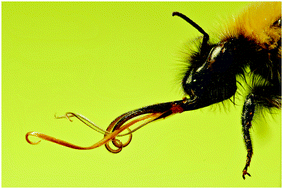Collection of nectar by bumblebees: how the physics of fluid demonstrates the prominent role of the tongue's morphology
Abstract
Bumblebees and some other tiny animals feed on nectar by visiting flowers in their neighborhood. Some bee species appear to be highly specialized, their tongue being adapted to specific flowers. Bombus terrestris in contrast is able to feed on a wide variety of flowers and can thus be considered as a kind of universal nectar catcher. Since plant nectars show highly variable sugar content, Bombus terrestris have developed a capture mechanism that works for almost any fluid viscosity. Their tongues are decorated with very elongated papillae forming a hairy coating surrounding a rod-like main stalk. When settled on a flower, Bombus rapidly dip their tongue into the inflorescence to catch the highly sought-after nectar. To determine the physical mechanism at the origin of this outstanding ability, the capture dynamics was followed from videos recorded during viscous fluid ingestion. Surprisingly, the volume per lap and the lapping frequency are independent of the fluid viscosity over three orders of magnitude. To explain this observation, we designed a physical model of viscous dipping with structured rods. Predictions of the model compared to observations for bees showed that the nectar is not captured with the help of viscous drag, as proposed in the Landau–Levich–Derjaguin model, but thanks to the hairy structure that traps the viscous fluid, capillary forces drastically limiting the drainage. Our approach can be transposed to others nectar foragers such as bats and hummingbirds.



 Please wait while we load your content...
Please wait while we load your content...